|
The Blue-eyed Scallop
The Atlantic Bay
Scallop , also named the Blue-eyed Scallop is a
"Molluscan maverick". The species has succeeded
by breaking or bending the rules of "bivalvery"
at almost every turn.
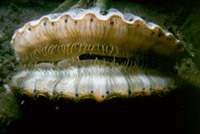
The shells are identical
(actually mirror images of one another) except
for the color. The top shell is darker,
often with bands of alternating brown and cream.
The bottom shell is white. Both shells are
strongly ribbed, with up to twenty raised lines
radiating from the base. Scallops cannot dig as
clams do, so the dark top shell helps it to
camouflage as it sits on the dark, muddy bottom.
Weeds and sponges grow on it as well,
completing its disguise.
Scallops spend most of
their time resting on the sea floor with their
shells slightly open to feed. They are filter
feeders and catch their food by pumping water in
through the front of the shell and out through
the back. Any food particles, such as small
bits of algae, diatoms, and bacteria, are
trapped inside.
The shells are more
lightweight than clams or oysters, and the
reason for this is that the scallop is one of
the few type of bivalve the Northeastern
Atlantic region that can actually swim.
Tiny yellow hair-like projections stick out between the shells when the
animal is at rest. These are sensitive to
chemicals in the water. When they sense a
predator, such as a sea star, the scallop opens
its shells wide, drawing in water, then clamps
the shells quickly shut. As the shell closes,
the mantle, which is a thin sheet-like organ
that actually creates the shell, seals the
opening. This forces all of the water to shoot
out through the back hinges of the shells,
moving it forward through the water, and away
from the predator, via jet propulsion.
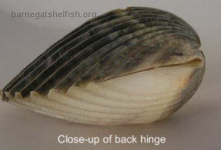
Scallops swim in a zigzag
motion with the rounded part of the body forward
and occasionally bounce off the bay bottom.
Swimming can last anywhere
from a few seconds to a couple of minutes,
depending on water currents and the severity of
the threat. A potential predator that the
scallop perceives as more of an annoyance, such
as a sea urchin, may cause the scallop to just
give itself a short, quick burst to move it away
from the danger. The scent of a sea star,
probably the deadliest predator an adult scallop
is likely to face, will cause it to go ballistic
as it desperately tries to put as much distance
between itself and the enemy as possible.
Scallop
swimming video
<click here>
The decision to swim away
from a predator or close its shells tightly
depends on the type of predator that is near it.
If the predator sensed is able to open the
shell, the swimming defense kicks in. If the
predator cannot then the scallop simply seals
its shells up until the danger passes.
A bivalve's strength comes
from muscles called adductors. Most have two, and these work
together to clamp the shells tightly shut. To
open the shells slightly, as they do when
feeding, these muscles are simply relaxed a bit.
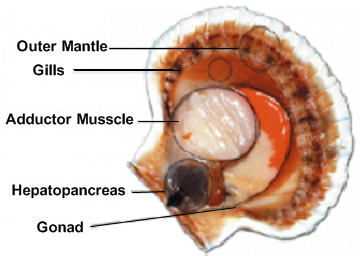
The Bay Scallops only have
one, but it is a whopper. This is where the
power comes from which allows this animal to
swim. In the diagram to the right, (courtesy of
www.food.gov.uk) you can see the enormous
size of this muscle, as well as some of the
other anatomical features. Notice especially
the size of the gonads.
Scallops are
hermaphrodites. Each animal is both male and
female, although they do not self-fertilize (the
sex cells of each individual mature at different
rates). When the gonads are fully formed they
are simply released into the water column to mix
by chance with that of other individuals. Water
temperature cues trigger the release so that all
gravid scallops in an area spawn at the same
time. This greatly increases the odds that the
eggs will be fertilized, and scallops have only
one chance at this so they need to make it
count. All bay scallops spawn when they are two
years old. Then they die.
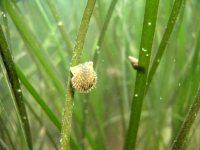 Larval scallops are
planktonic and in a few days they will form a
rudimentary shell (this stage is called a
"spat") and settle to the bottom to grow.
However there is a catch. Scallops live in
muddy bays and harbors and a tiny spat that
lands on the mud will suffocate from the silt.
The larva must find something suspended above
the mud to hang on to until it is big enough to
resist being silted to death. Eelgrass is the
predominant plant (and it is a true plant) in
scallop habitats and is a vitally important
substrate for the young mollusk to attach itself
to. Larval scallops are
planktonic and in a few days they will form a
rudimentary shell (this stage is called a
"spat") and settle to the bottom to grow.
However there is a catch. Scallops live in
muddy bays and harbors and a tiny spat that
lands on the mud will suffocate from the silt.
The larva must find something suspended above
the mud to hang on to until it is big enough to
resist being silted to death. Eelgrass is the
predominant plant (and it is a true plant) in
scallop habitats and is a vitally important
substrate for the young mollusk to attach itself
to.
Like mussels, scallops can
produce byssal threads using a small gland at
the base of the shell. The spat uses these
thin, sticky threads to hold on to the blade of
the plant. Adults also can produce
byssus and
the threads, when the scallop needs to swim, can
be instantly snapped at will.
During the 1930's a fungus
known as "eelgrass blight" decimated the plant
all along the Atlantic coast. It took decades
for the grass beds to recover. During these
years the scallop fishery literally vanished.
Now,
about those eyes. When the scallop's shell is
gaped you can see two rows of tiny, bright
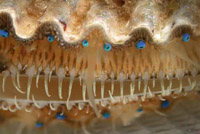 blue
eyes. This species has forty of them. And
these aren't the simple light sensitive eyes
that most mollusks have (discounting, of course,
the incredible sight possessed by cephalopods).
They can also sense motion, so a crab or fish
trying to sneak up on one and grab some flesh
before the shells close will be seen before it
gets even close. And if the scallop loses an
eye it simply regenerates a new one in its
place. blue
eyes. This species has forty of them. And
these aren't the simple light sensitive eyes
that most mollusks have (discounting, of course,
the incredible sight possessed by cephalopods).
They can also sense motion, so a crab or fish
trying to sneak up on one and grab some flesh
before the shells close will be seen before it
gets even close. And if the scallop loses an
eye it simply regenerates a new one in its
place.
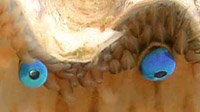
To the right is an ultra close-up of the eye.
(The color hasn't been tampered with)
|
